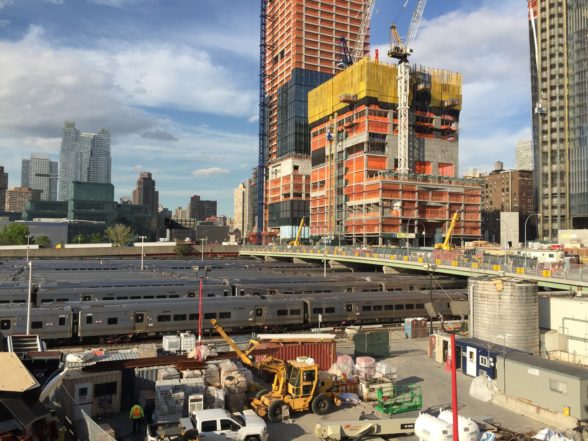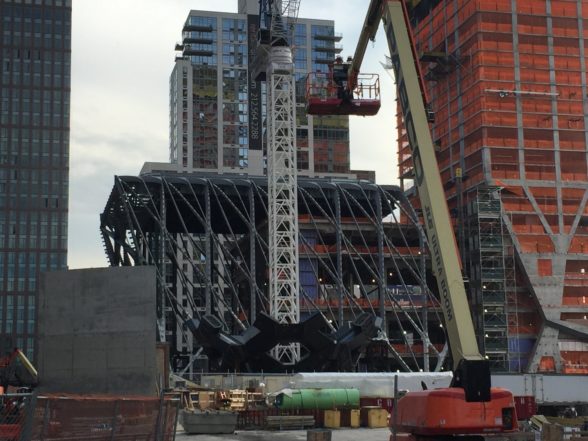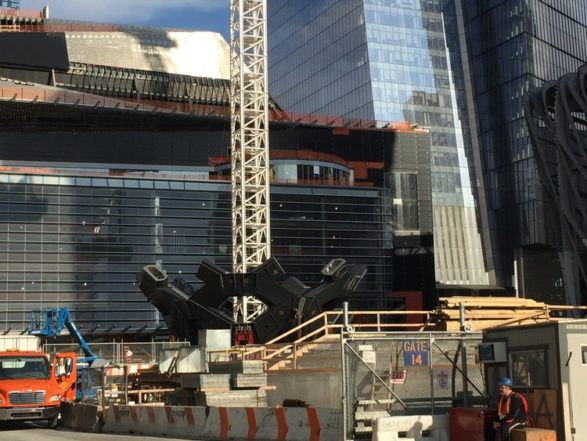
Walker Thisted, BuiltWorlds producer and resident architect, traveled to New York last month and took a look at Hudson Yards, the big redevelopment project on Manhattan’s west side. Here’s his take.

In cities around the world, we’re seeing surface level infrastructure buried to accommodate the demand for increasingly dense urban development. From the Big Dig in Boston to the Porte d’Orleans in Paris and Millennium Park in Chicago, these projects reflect the changing ways in which cities are inhabited, accessed, and redeveloped.
In particular, they highlight a trend towards re-urbanization, a desire to live in locations with access to public transportation and nearby employment, and a willingness to sacrifice large living spaces to do so. It’s reflective of a desire to beautify cities — or even erase their industrial past — by increasing the amount of public and green space as well as cultural, culinary, and recreational amenities to enhance the attractiveness of these new developments.
The benefit? We’re seeing parts of many cities that otherwise might have been overlooked or unused become activated.
In the case of Hudson Yards in New York, located on the 28-acre West Side Rail Yard between 34th and 30th Streets, 10th Ave., and the Hudson River, the sheer scale of the project and potential to generate a new neighborhood was enticing.
Proposals to build on the air rights of the yard (which conveniently includes space between the tracks to accommodate columns for future development) stretch back to the 1950s and have recently included plans for the new Jets Stadium designed in conjunction with a failed Olympic bid.

The master plan of the current phase of development, however, was released by the New York City Department of City Planning in 2003. The city called for an extension of the #7 subway line to support the new development as well as several public green spaces.
Tishman Speyer won the initial bid and a revised master plan was soon executed by Kohn, Pedersen, Fox Architects. Following the 2008 financial crisis, that deal broke down. The city then selected Related Companies (their VP of development Michael Ellch spoke at our Summit last month) and Goldman Sachs to develop what would become the largest private real estate development in U.S. History and the largest in New York since the Rockefeller Center.
The first phase of the project includes many features designed to attract residents and businesses to this new section of the city. This approach to place-making is one of the most innovative components of the project and includes a considerable investment in enhancing the cultural life by creating The Shed in collaboration with Diller Scofidio + Renfro.
THE SHED

Designed as a flexible cultural space that can accommodate shows (such as the annual New York Fashion Week), The Shed uses an innovative moving shell engineered in collaboration with Thornton Tomasetti that allows the building to capture more of the outdoor plaza when necessary and nest within the high rise building when not in use.

In addition to The Shed, Related Companies founder and CEO personally commissioned Thomas Heatherwick to create The Nest, an M.C. Escher-like structure, as the central showpiece of the nearby plaza.
The Hudson Yards is also integrated with Phase 3 of the High Line, the development of a number of new art gallery spaces, and the construction of iconic luxury apartments by famed architects such as Zaha Hadid. (Zaha Hadid’s U.S. Director, Tiago Correia, spoke on a panel about architectural practice in the 21st century at this year’s Summit.)
RETURN ON INVESTMENT
The cost of Hudson Yards is already more than $20B, and developers and investors are looking to recoup their investment through high rents and luxury condo sales — you can buy the penthouse at the Hadid building for a cool $50M.
Corporate offices will also anchor the neighborhood. Coach, who is also a debt and equity investor, L’Oreal, and the Boston Consulting Group are all early tenants. Hudson Yards will also claim the first Manhattan location of Neiman Marcus to help drive visitors and support consumer spending.

HOW HUDSON YARDS COMPARES
The Hudson Yards development is already getting a pricey reputation, which stands in stark contrast to that of neighboring Hell’s Kitchen, a neighborhood that was historically dangerous (hence the name, supposedly) before its modern gentrification in the 1990s.
The trend of using real estate development to erase violence and blight began years earlier with the incursion of the Lincoln Tunnel through the center of Hell’s Kitchen. But Hudson Yards has been more focused on creating an attractive local experience and sense of place, making it far more sensitive than previous urban infrastructure interventions. The result will likely be a new neighborhood that is well integrated with the fabric of the city.
We hope to see it become a resource for a wide range of people in much the same way that so many of New York’s other iconic public and green spaces have become.


Discussion
Be the first to leave a comment.
You must be a member of the BuiltWorlds community to join the discussion.